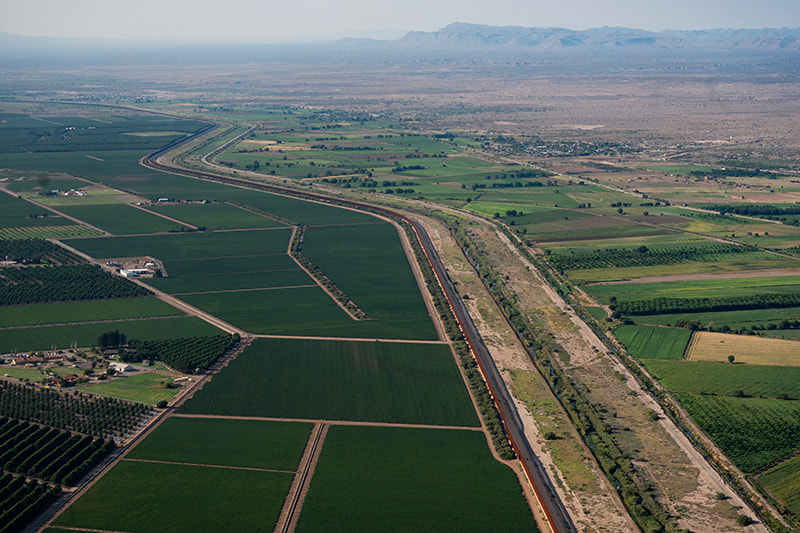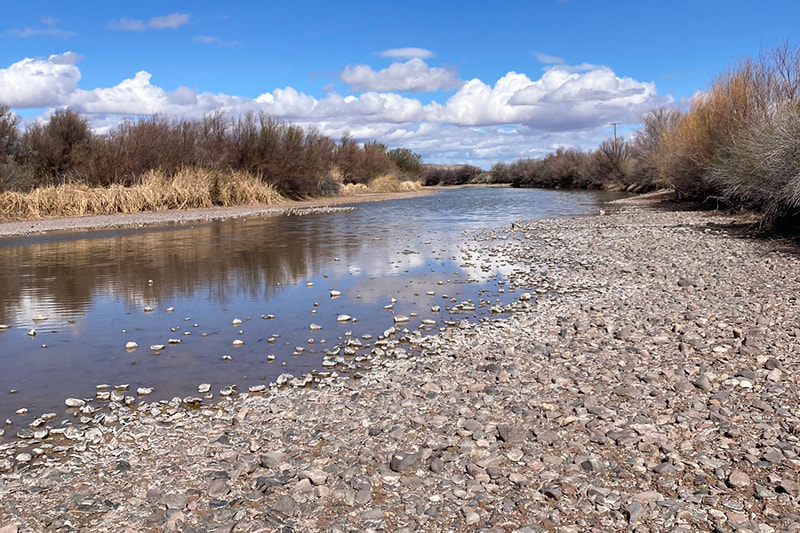Texas sued New Mexico over Rio Grande water. Now the states are fighting the federal government.11/6/2024 By: Martha Pskowski, Inside Climate News - This article originally appeared on Inside Climate News (hyperlink to the original story), a nonprofit, non-partisan news organization that covers climate, energy and the environment. Sign up for their newsletter here. Reporting supported with a grant from The Water Desk at the University of Colorado Boulder. DENVER—When Judge D. Brooks Smith traveled from Pennsylvania to Colorado, he passed over the 98th Meridian, the longitude line separating the water-rich East from the arid West. The former chief judge of the U.S. Third Circuit Court of Appeals left a land of rushing rivers and ample rainfall in western Pennsylvania to gather facts in a case called Texas v. New Mexico Supreme Court over water rights from the Rio Grande. Now a senior judge in the Third Circuit, Smith is serving as a special master to advise the U.S. Supreme Court on what is one of the longest-running disputes over dwindling water in the West, which also involves the federal government. Smith traveled for a five-hour status conference last week at Denver’s federal courthouse involving attorneys representing the states, the federal government and several intervenors known as friends of the court. At issue is the water Texas and New Mexico are entitled to under the Rio Grande Compact, signed in 1938 to allocate the waters of the Rio Grande between the states. Texas brought the current lawsuit against New Mexico in 2013, alleging that farmers pumping from groundwater wells in southern New Mexico were diverting water that the compact allocates to Texas. The states reached a proposed settlement agreement in 2022 out of court. But the federal government opposed the deal. The Supreme Court then ruled in June that the case could not be settled without the federal government’s consent. Now the states and the federal government must resolve their disagreements to avoid going to trial in federal court, and Smith has ordered the parties to return to mediation no later than Dec. 16 in Washington, D.C. The outcome of Texas v. New Mexico could fundamentally change how groundwater is managed in the Rio Grande basin in New Mexico and far west Texas, both for the agricultural industry and cities like Albuquerque and Las Cruces, in New Mexico, that pump water from aquifers. It will also be a bellwether for how deeply the federal government can intervene in inter-state water conflicts, which are likely to increase as drought and aridification grip the western United States. “[The United States] is going to have to take some sort of action to get a handle on groundwater over-pumping,” said Burke Griggs, a professor of water law at Washburn University in Topeka, Kansas. “They really do want to keep the case alive.” Groundwater Pumping Complicates Water Sharing Agreements The Rio Grande forms in the San Juan Mountains of Colorado before flowing south through New Mexico to the Texas border. By the turn of the 20th century, disputes over Rio Grande water were brewing between farmers in southern New Mexico’s Mesilla Valley and those in El Paso, Texas, and neighboring Ciudad Juárez in Mexico. To address these concerns, Congress extended the Reclamation Act of 1902 to the Rio Grande in 1905 through the Mesilla Valley and El Paso. This allowed the Bureau of Reclamation, the federal agency responsible for water management and dam building in 17 Western states, to undertake the Rio Grande Project, which included construction of the Elephant Butte Dam and irrigation infrastructure downstream. Once completed, the Bureau of Reclamation began delivering water stored at Elephant Butte to two new irrigation districts: New Mexico’s Elephant Butte Irrigation District, and the El Paso County Water Improvement District No. 1 in Texas. Further complicating matters, the U.S. and Mexico signed a treaty in 1906 committing the U.S. to providing 60,000 acre feet of Rio Grande water to Mexico at Ciudad Juárez annually. Meanwhile, over the ensuing three decades, farmers in Colorado’s San Luis Valley and along the Rio Grande near Albuquerque were using more and more water for irrigation. Texas farmers worried this could jeopardize their irrigation water; an agreement was needed to ensure the water wouldn’t be all diverted upstream. Thus, in 1938, Texas, New Mexico and Colorado signed the Rio Grande Compact, designating how much water Colorado must ensure would reach New Mexico, which in turn had to ensure a fair share of water would reach Texas. A deep drought gripped the region in the 1950s. With less river water available for irrigation, farmers began to drill wells and pump groundwater. Hydrologists now understand that wells drilled into the aquifer can reduce the flow of water into connected streams and rivers, and New Mexico state law evolved to manage groundwater and surface water together. The state was a pioneer in understanding this connection, according to Fred Phillips, emeritus professor of hydrology and environmental science at New Mexico Tech in Socorro, New Mexico. “However, the Rio Grande Compact was put together long before that all happened,” he said in an interview. “It was entirely based on surface flow measurements, and nowhere in the compact is the effect of pumping even considered.” When the Bureau of Reclamation releases water from Elephant Butte and Caballo Lake in New Mexico, it must travel roughly 100 river miles to the Texas-New Mexico state line. Texas brought the suit in 2013, arguing that groundwater pumping in this stretch of New Mexico siphoned off water destined for Texas under the Rio Grande Compact. The United States and Colorado later both became parties to the lawsuit. In 2022, Texas, New Mexico and Colorado proposed a consent decree to settle the case. The states wanted to install a new water gage at the Texas-New Mexico border on the Rio Grande, which would measure Texas’ share of water. Under the agreement, southern New Mexico would receive 57 percent of the water released from the upstream reservoirs and Texas 43 percent, accounting for drought and groundwater pumping. The states proposed calculating water deliveries based on what’s known as the “D2 period” between 1951 and 1978, when significant groundwater pumping had already begun. But the federal government opposed the agreement. Its attorneys argued the deal did not reflect the United States’ treaty obligation to deliver water to Mexico, the Bureau of Reclamation’s role in water deliveries and its contracts with the irrigation districts. The federal government advocates for a return to a 1938 baseline for water deliveries, before the advent of widespread groundwater pumping. This June, the Supreme Court ruled 5-4 to reject the consent decree, ruling that the states cannot reach a settlement without the federal government. “That Texas’s litigation strategy has since changed, such that it is now willing to accept a greater degree of groundwater pumping, does not erase the United States’ independent stake in pursuing claims against New Mexico,” Justice Ketanji Jackson wrote for the majority. “We cannot now allow Texas and New Mexico to leave the United States up the river without a paddle,” she wrote. Justice Neil Gorsuch delivered the dissenting opinion. “Where does that leave the States? After 10 years and tens of millions of dollars in lawyers’ fees, their agreement disappears with only the promise of more litigation to follow,” he wrote. Gorsuch added that the decision could also hinder future cooperation between states and the federal government in water disputes. “I fear the majority’s shortsighted decision will only make it harder to secure the kind of cooperation between federal and state authorities reclamation law envisions and many river systems require,” he wrote. How to Manage a Declining RiverWashburn University’s Griggs, the author of a forthcoming paper in the Idaho Law Review on the case, said many water law experts were surprised when the Supreme Court rejected the consent decree.
“States that settle water disputes are now going to think twice,” he said. “It’s a real wrinkle we haven’t seen before, where a non-party to a compact can intervene and then block a settlement.” Griggs said that settlements are preferable in these inter-state water disputes because expert attorneys can craft the agreements. “Do we want to leave the water future of millions of Westerners in the hands of nine Eastern justices?” he said. “You want negotiated settlements that are done by the level and talent of the lawyers involved in this case.” But he acknowledged that the Supreme Court’s ruling is “legally understandable” because the Bureau of Reclamation has a clear role in executing the Rio Grande Compact. Thomas Snodgrass, a Justice Department attorney representing the Bureau of Reclamation, articulated this role in his presentation to Judge Smith. He said that the bureau must release more water because of New Mexico’s failure to regulate groundwater pumping. “Simply put, groundwater pumping is not sustainable,” Snodgrass said. The New Mexico Pecan Growers, the City of Las Cruces and the Albuquerque Bernalillo County Water Utility Authority, among those filing amicus briefs, have sided with the states but technically are not parties to the case. The Albuquerque water authority’s attorney warned against the “federalization of groundwater” and said the federal government’s position could be “disastrous” for existing groundwater permitting in New Mexico.
0 Comments
Your comment will be posted after it is approved.
Leave a Reply. |
Submit your ideas for local feature articles
Profiles Gardening Recipes Observations Birding Essays Hiking AuthorsYou! Archives
October 2025
Categories
All
|



 RSS Feed
RSS Feed